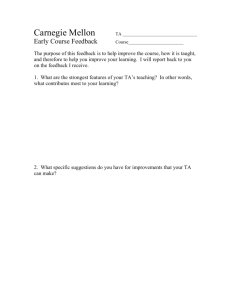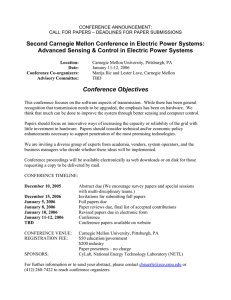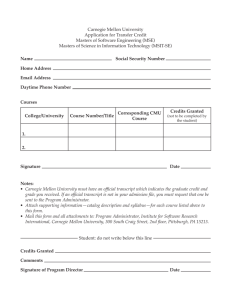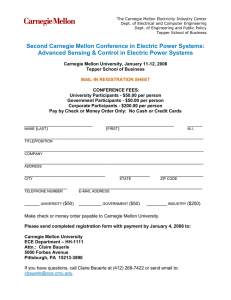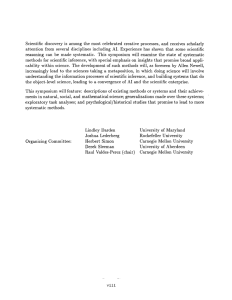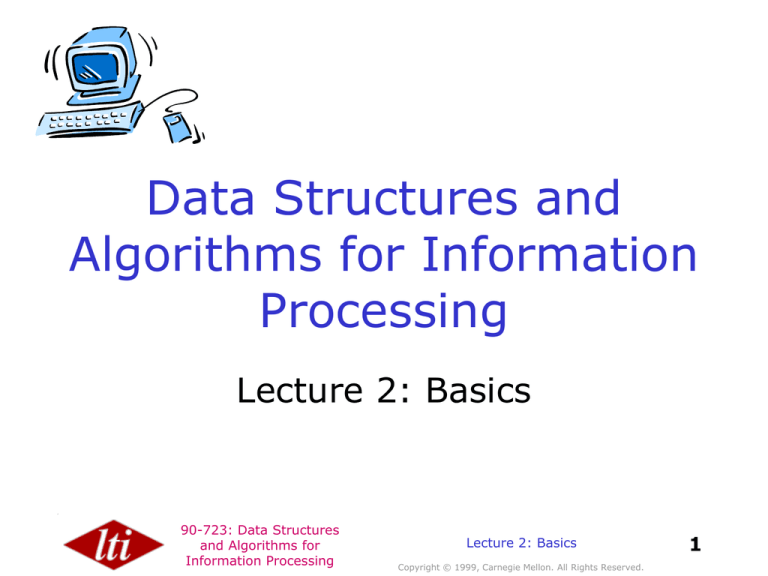
Data Structures and
Algorithms for Information
Processing
Lecture 2: Basics
90-723: Data Structures
and Algorithms for
Information Processing
Lecture 2: Basics
Copyright © 1999, Carnegie Mellon. All Rights Reserved.
1
Today’s Topics
• Intro to Running-Time Analysis
• Summary of Object-Oriented
Programming concepts (see slides
on schedule).
90-723: Data Structures
and Algorithms for
Information Processing
Lecture 2: Basics
Copyright © 1999, Carnegie Mellon. All Rights Reserved.
2
Running Time Analysis
• Reasoning about an algorithm’s
speed
• “Does it work fast enough for my
needs?”
• “How much longer when the input
gets larger?”
• “Which algorithm is fastest?”
90-723: Data Structures
and Algorithms for
Information Processing
Lecture 2: Basics
Copyright © 1999, Carnegie Mellon. All Rights Reserved.
3
Elapsed Time vs.
No. of Operations
• Q: Why not just use a stopwatch?
• A: Elapsed time depends on
independent factors
• Number of operations carried out
is the same for two runs of the
same code with the same
arguments -- no matter what the
environment might be
90-723: Data Structures
and Algorithms for
Information Processing
Lecture 2: Basics
Copyright © 1999, Carnegie Mellon. All Rights Reserved.
4
Stair-Counting Problem
• Two people at the top of the Eiffel
Tower
• Three methods to count the steps
– X walks down, keeping a tally
– X walks down, but Y keeps the tally
– Z provides the answer immediately
(2689!)
90-723: Data Structures
and Algorithms for
Information Processing
Lecture 2: Basics
Copyright © 1999, Carnegie Mellon. All Rights Reserved.
5
Stair-Counting Problem
• Choosing the operations to count
– Actual time? Varies due to several
factors not related to the efficiency of
the algorithm
– Each time X walk up or down one
step = 1 operation
– Each time X or Y marks a symbol on
the paper = 1 operation
90-723: Data Structures
and Algorithms for
Information Processing
Lecture 2: Basics
Copyright © 1999, Carnegie Mellon. All Rights Reserved.
6
Stair-Counting Problem
• How many operations for each of
the 3 methods?
• Method 1:
– 2689
– 2689
– 2689
– 8067
steps down
steps up
marks on the paper
total operations
90-723: Data Structures
and Algorithms for
Information Processing
Lecture 2: Basics
Copyright © 1999, Carnegie Mellon. All Rights Reserved.
7
Stair-Counting Problem
• Method 2:
– 3,616,705 steps down
(1+2+…+2689)
– 3,616,705 steps up
– 2689 marks on the paper
– 7,236,099 total operations
90-723: Data Structures
and Algorithms for
Information Processing
Lecture 2: Basics
Copyright © 1999, Carnegie Mellon. All Rights Reserved.
8
Stair-Counting Problem
• Method 3:
– 0 steps down
– 0 steps up
– 4 marks on the paper (one for each
digit)
– 4 total operations
90-723: Data Structures
and Algorithms for
Information Processing
Lecture 2: Basics
Copyright © 1999, Carnegie Mellon. All Rights Reserved.
9
Analyzing Programs
• Count operations, not time
– operations is “small step”
– e.g., a single program statement; an
arithmetic operation; assignment to a
variable; etc.
• No. of operations depends on the
input
– “the taller the tower, the larger the
number of operations”
90-723: Data Structures
and Algorithms for
Information Processing
Lecture 2: Basics
Copyright © 1999, Carnegie Mellon. All Rights Reserved.
10
Analyzing Programs
• When time analysis depends on
the input, time (in operations) can
be expressed by a formula:
– Method 1:
3n
2
n
2
(
1
2
...
n
)
n
2n
– Method 2:
– Method 3: no. of digits in number n
log 10 n 1
90-723: Data Structures
and Algorithms for
Information Processing
Lecture 2: Basics
Copyright © 1999, Carnegie Mellon. All Rights Reserved.
11
Big-O Notation
• The magnitude of the number of
operations
• Less precise than the exact
number
• More useful for comparing two
algorithms as input grows larger
• Rough idea: “term in the formula
which grows most quickly”
90-723: Data Structures
and Algorithms for
Information Processing
Lecture 2: Basics
Copyright © 1999, Carnegie Mellon. All Rights Reserved.
12
Big-O Notation
• Quadratic Time
– largest term no more than c n 2
– “big-O of n-squared” On 2
– doubling the input increases the
number of operations approximately
4 times or less
– e.g.
• Method 2(100) = 10,200
• Method 2(200) = 40,400
90-723: Data Structures
and Algorithms for
Information Processing
Lecture 2: Basics
Copyright © 1999, Carnegie Mellon. All Rights Reserved.
13
Big-O Notation
• Linear Time
– largest term no more than c n
– “big-O of n” On
– doubling the input increases the
number of operations approximately
2 times or less
– e.g.
• Method 1(100) = 300
• Method 1(200) = 600
90-723: Data Structures
and Algorithms for
Information Processing
Lecture 2: Basics
Copyright © 1999, Carnegie Mellon. All Rights Reserved.
14
Big-O Notation
• Logarithmic Time
– largest term no more than c log n
– “big-O of log n” Olog n
– doubling the input increases the
running time by a fixed number of
operations
– e.g.
• Method 3(100) = 3
• Method 3(1000) = 4
90-723: Data Structures
and Algorithms for
Information Processing
Lecture 2: Basics
Copyright © 1999, Carnegie Mellon. All Rights Reserved.
15
Summary
• Method 1: On
2
O
n
• Method 2:
• Method 3: Olog n
• Run-time expressed with big-O is
the order of the algorithm
• Constants ignored:
order (37n) order (2n) O(n)
90-723: Data Structures
and Algorithms for
Information Processing
Lecture 2: Basics
Copyright © 1999, Carnegie Mellon. All Rights Reserved.
16
Summary
• Order allows us to focus on the
algorithm and not on the speed of
the processor
• Quadratic algorithms can be
impractically slow
90-723: Data Structures
and Algorithms for
Information Processing
Lecture 2: Basics
Copyright © 1999, Carnegie Mellon. All Rights Reserved.
17
Comparison
O(log N)
O(n)
O(n2)
n
Method 3
Method 1
Method 2
10
2
30
120
100
3
300
10,200
1000
4
3000
1,002,000
10,000
5
30,000
100,020,000
90-723: Data Structures
and Algorithms for
Information Processing
Lecture 2: Basics
Copyright © 1999, Carnegie Mellon. All Rights Reserved.
18
Time Analysis of Java
Methods
• Example: search method (p. 26)
public static boolean search(double[] data, double target) {
int i;
for (i=0; i<data.length; i++) {
if (data[i] == target) return true;
}
return false;
}
90-723: Data Structures
and Algorithms for
Information Processing
Lecture 2: Basics
Copyright © 1999, Carnegie Mellon. All Rights Reserved.
19
Time Analysis of Java
Methods
• Operations: assignment,
arithmetic operators, tests
– Loop start: two operations:
initialization assignment, end test
– Loop body: n times if input not
found; assume constant k operations
– Return: one operation
– Total: kn 3 O(n)
90-723: Data Structures
and Algorithms for
Information Processing
Lecture 2: Basics
Copyright © 1999, Carnegie Mellon. All Rights Reserved.
20
Time Analysis of Java
Methods
• A loop that does a fixed number of
operations n times is O(n)
90-723: Data Structures
and Algorithms for
Information Processing
Lecture 2: Basics
Copyright © 1999, Carnegie Mellon. All Rights Reserved.
21
Time Analysis of Java
Methods
• worst-case: maximum number of
operations for inputs of given size
• average-case: average number of
operations for inputs of given size
• best-case: fewest number of
operations for inputs of given size
• any-case: no cases to consider
• Pin the case down and think about
n growing large – never small.
90-723: Data Structures
and Algorithms for
Information Processing
Lecture 2: Basics
Copyright © 1999, Carnegie Mellon. All Rights Reserved.
22
Object-Oriented Overview
• Slides from Main’s Lecture
90-723: Data Structures
and Algorithms for
Information Processing
Lecture 2: Basics
Copyright © 1999, Carnegie Mellon. All Rights Reserved.
23

